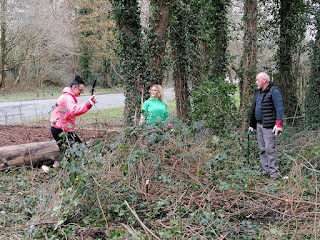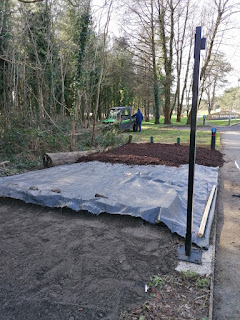Records for rainfall are being broken all over Wales judging by the levels of standing water across Pembrey Country Park and the Nature Reserve we have had our fair share, of course without the devastating impact that other areas have suffered. As reported in previous blogs the most dramatic impacts we have seen are along the coast with our nationally important sand dunes bearing the brunt.
A feature which has come to light with the erosion is the way in which the dunes have formed over recent times, by this I mean that you should look closely at the newly exposed faces of the dunes (keep a safe distance) and see for yourselves the interwoven driftwood, plastic and other manmade objects embedded in layers into the dunes.
For the geology students among you the image is one of sedimentary deposition as the different layers are very clear.
The dunes are usually formed when grains of sand collect against a fixed object, such as driftwood; this catches and holds the sand allowing accumulations to form, eventually forming embryonic dunes, these are low lying mounds which gradually hold more and more wind and sea deposited sand building into higher ridges, eventually forming recognisable sand dunes. This is usually over periods of 10's of years but can be quicker or slower depending on prevailing conditions and influences.
Removing or burning driftwood removes the ability for faster rebuilding and therefore stabilisation of the embryonic dunes, this is another reason why driftwood should usually be left where it is.
If you have visited Cefn Sidan during the recent storms you will have seen the amount of driftwood and marine debris washed up, especially at the main beach entrance, you may now notice it has disappeared, well we have not buried it, some has been physically moved down the beach to make access safer, although the majority has been moved naturally by the tides no doubt deposited further east along the beach; this is called longshore drift as illustrated.
 |
| Wikipedia image |
Visitors may well have seen one of our team in a tractor digging away in several places on the beach in recent weeks, he was not burying anything just the opposite, initially he was uncovering an almost complete Whale skeleton- more on this in the future, he then spent days locating our emergency rendevous point signs dislodged and buried by the storm, seemed more sensible to look for the signs than just buy new ones!!!!
We must remember that we are dealing with nature, and as such events and outcomes are unpredictable; but if you want to learn more about Cefn Sidan and the dunes look out for upcoming guided events through 2020.
What's on this coming weekend... Food and Drink Festival Saturday 29th Feb' and Sunday 1st March


































